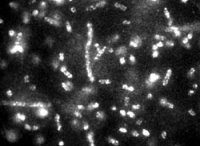Quantum dot method rapidly identifies bacteria
The fluorescence signal is strong and stable for hours, enabling scientists to count the number of phage viruses bound to a cell. Credit: NCI/NIST, Usage Restrictions: NoneA rapid method for detecting and identifying very small numbers of diverse bacteria, from anthrax to E. coli, has been developed by scientists from the National Cancer Institute (NCI) and National Institute of Standards and Technology (NIST). Described in the March 28 issue of Proceedings of the National Academy of Sciences,* the work could lead to the development of handheld devices for accelerated identification of biological weapons and antibiotic-resistant or virulent strains of bacteria--situations where speed is essential.
Traditional ways of identifying infectious bacteria and their possible treatments can be time consuming and laborious, requiring the isolation and growth of the bacteria over many hours or even days. The new method speeds up the process by using fast-replicating viruses (called bacteriophages or phages) that infect specific bacteria of interest and are genetically engineered to bind to "quantum dots." Quantum dots are nanoscale semiconductor particles that give off stronger and more intense signals than conventional fluorescent tags and also are more stable when exposed to light. The method detects and identifies 10, or fewer, target bacterial cells per milliliter of sample in only about an hour.
The phages were genetically engineered to produce a specific protein on their surface. When these phages infect bacteria and reproduce, the bacteria burst and release many phage progeny attached to biotin (vitamin H), which is present in all living cells. The biotin-capped phages selectively attract specially treated quantum dots, which absorb light efficiently over a wide frequency range and re-emit it in a single color that depends on particle size. The resulting phage-quantum dot complexes can be detected and counted using microscopy, spectroscopy or flow cytometry, and the results used to identify the bacteria. The new method could be extended to identify multiple bacterial strains simultaneously by pairing different phages with quantum dots that have different emission colors.
The new method is more sensitive than conventional optical methods. It can count how many viruses are infecting a single bacteria cell and how many quantum dots are attached to a single virus. A provisional patent application was filed originally through NIST, and a non-provisional patent application was filed more recently through the National Institutes of Health, the parent agency of NCI. The NIST contributions to the work include experimental design and fluorescence imaging. Other authors are from NCI, NIH, SAIC-Frederick Inc. and the National Cancer Institute at Frederick. ###
The work was funded by NIH, NCI, NIST, and the Center for Cancer Research.
* R. Edgar, M. McKinstry, J. Hwang, A.B. Oppenheim, R.A. Fekete, G. Giulian, C. Merril, K. Nagashima and S. Adhya. 2006. High sensitivity bacterial detection using biotin-tagged phage and quantum-dot nanocomplexes. Proceedings of the National Academy of Sciences. March 28.
Contact: Laura Ost laura.ost@nist.gov 301-975-4034 National Institute of Standards and Technology (NIST)
Technorati Tags: Nano or Nanotechnology and nanoparticles or Nanotech and microscopy or nanochemistry and nanoscale or bacteria and quantum dots or flow cytometry and mesoporous nanospheres or bacteriophages and anticancer or semiconductor nanocrystals
Related: Keyword Nanotech Sunday, March 26, 2006 'Custom' nanoparticles, cancer diagnosis and treatment, Sunday, March 26, 2006, Green nanochemistry, American Chemical Society symposium, Sunday, March 19, 2006 nanotechnologists demonstrate artificial muscles powered by highly energetic fuels, Sunday, Sunday, March 12, 2006 magnetic phenomenon may improve RAM memories, February 26, 2006 Nanoscience study shows that quantum dots 'talk', Sunday, February 26, 2006 Nano-bots to undertake major tasks?, Sunday, February 19, 2006 Nanotech to improve health care delivery, Sunday, February 19, 2006 nano-canary in the nanotoxicology coalmine, Sunday, December 04, 2005 Nano-cages 'fill up' with hydrogen, Sunday, November 13, 2005 Testing toxicity of nanomaterials, Sunday, October 23, 2005 single-molecule car, 'Nanocar', Sunday, August 28, 2005 Writing at the nanoscale, Thursday, May 26, 2005 discontinuous palladium, siloxane self-assembled monolayer, Sunday, May 08, 2005 Center for Nanoscale Materials, Monday, April 25, 2005 Nanomagnets, Nanocomposite, Monday, March 21, 2005 porphyrin tubes may lead to new nanodevices, inexpensive hydrogen fuel












1 comment:
Nanodots are tiny nano particles usually less than 50 nanometers large, that are part of the larger nano particle category called quantum dots. A quantum dot is a very tiny crystal that shines when stimulated by ultraviolet (UV) light. They are regions of semiconductors that are occupied by a few electrons. Recently, they are a part of nanotechnology, a science thought to have great potential in many areas of activity.
Post a Comment